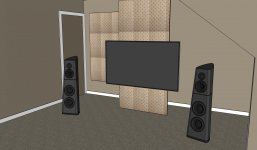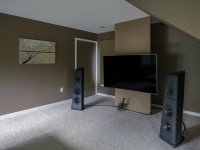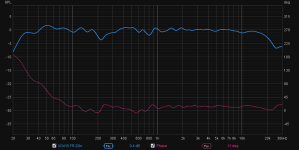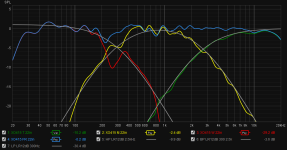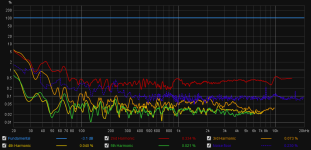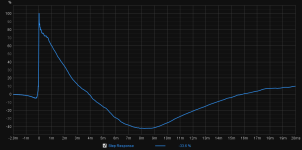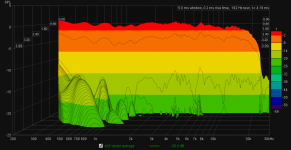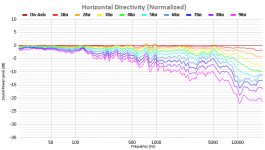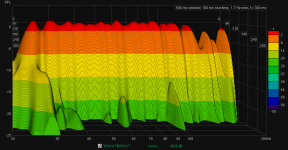Background and Design Premise
I built my first pair of DIY speakers 22 years ago, and despite planning something much more ambitious and expensive just a few years later, I managed to instead build speakers for friends and family and indulge other hobbies in those intervening years. Now I have made up for lost time by building something overly ambitious. I made the cabinet construction more difficult than it needed to be, not only to get an nth degree of additional performance, but to make something visually striking and different, to experiment with new techniques and materials, and to confirm I am capable of doing all of this. It had a lot of educational and entertainment value. Deliberate hurdles include:
Project Highlights
All 3D modeling was done in Sketchup, although there is additional routing and shaping I do not know how to do in Sketchup that I did on the completed speakers. I designed the exterior shape first, then worked my way inwards placing collections of parts on a separate layer so I could work on them in isolation. What I ended up with was the ability to explode the speaker and dimension all parts. Anything too complicated to build from a picture was printed 1:1 and adhered to plywood for cutting. For example, the horizontal bracing that is not perpendicular to the baffle has a different shape on the top than it does on the bottom, as the angle to the side of the brace changes several degrees from the front to the back. I had to first cut to the larger of the top/bottom profile for these pieces and then cut/sand at a variable angle to taper to the smaller profile. This worked reasonably well, but with ~1mm tolerance on all finished dimensions, it added up to a lot of slop during assembly, and I had to fill a lot of gaps with glue or resin.
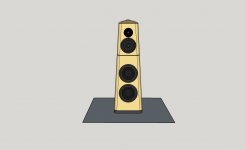
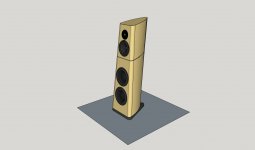
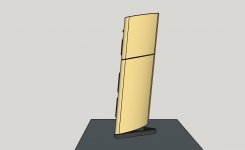
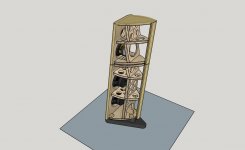
Project Details
TMWW + SS: 3-way active tower speakers plus dual driver mono sub with 8 channels of amplification.
Drivers:
Sample construction details:
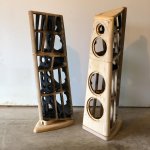
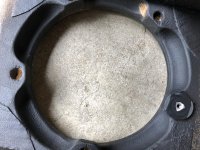
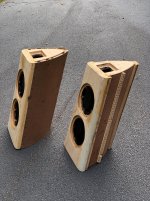
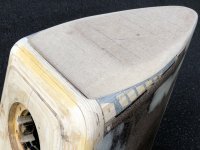
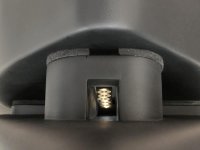
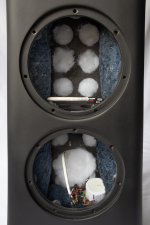
Full design and build galleries.
I built my first pair of DIY speakers 22 years ago, and despite planning something much more ambitious and expensive just a few years later, I managed to instead build speakers for friends and family and indulge other hobbies in those intervening years. Now I have made up for lost time by building something overly ambitious. I made the cabinet construction more difficult than it needed to be, not only to get an nth degree of additional performance, but to make something visually striking and different, to experiment with new techniques and materials, and to confirm I am capable of doing all of this. It had a lot of educational and entertainment value. Deliberate hurdles include:
- Physical design impossible with pencil and paper; blueprints needed to be created using CAD.
- Complicated construction techniques beyond my initial skillset.
- Unproven materials and joinery.
- Shape requires painting, which is 100x as difficult for me as staining and finishing real wood.
- I have never been happy with the reliability of my measurements <500Hz, and this is a 3-way.
Project Highlights
- Unique, sculpted appearance.
- Cabinets are low diffraction, high mass, highly damped.
- Creative construction techniques to account for my lack of tooling and skill.
- All drivers from Scanspeak. Tweeters and mids decoupled from cabinet with Sorbothane gaskets and anchors. Construction-wise, this worked as anticipated, but I have no measurements to prove it was worth the hassle.
- Active DSP crossovers.
- Hypex amplification with one amplifier channel per crossover region.
All 3D modeling was done in Sketchup, although there is additional routing and shaping I do not know how to do in Sketchup that I did on the completed speakers. I designed the exterior shape first, then worked my way inwards placing collections of parts on a separate layer so I could work on them in isolation. What I ended up with was the ability to explode the speaker and dimension all parts. Anything too complicated to build from a picture was printed 1:1 and adhered to plywood for cutting. For example, the horizontal bracing that is not perpendicular to the baffle has a different shape on the top than it does on the bottom, as the angle to the side of the brace changes several degrees from the front to the back. I had to first cut to the larger of the top/bottom profile for these pieces and then cut/sand at a variable angle to taper to the smaller profile. This worked reasonably well, but with ~1mm tolerance on all finished dimensions, it added up to a lot of slop during assembly, and I had to fill a lot of gaps with glue or resin.




Project Details
TMWW + SS: 3-way active tower speakers plus dual driver mono sub with 8 channels of amplification.
Drivers:
- Tweeters: Scanspeak Illuminator D3304/6640 1” beryllium
- Mids: Scanspeak Revelator 18M/4631T00 7” slit cone
- Woofers: Dual Scanspeak Revelator 22W/8857T00 8” aluminum
- Subwoofers: Separate, part of previously completed project. Dayton Audio RSS315HF-4 12" Reference HF Subwoofer 4 Ohm
- Portability of extremely heavy cabinets improved by building separate TM cabinets which sit on top of WW cabinets, isolated by Sorbothane sheets.
- 1-1/2” thick baltic birch baffle laminated from two sheets with silicone adhesive constrained layer. Exterior of baffle slightly curved horizontally, with 1-1/4” roundovers on vertical edges, expanding into additional shaping around tweeters.
- Driver recesses inside baffle enlarged with cove bits to improve airflow and avoid resonances.
- Mids and tweeters decoupled from cabinet with 1/8” Sorbothane gaskets, and are bolted to hurricane nuts which are also decoupled from the cabinet with Sorbothane isolation bushings.
- Woofers are rigidly mounted with T-nuts.
- Baffle tapers from the floor up, and is tilted back 5 degrees to improve physical time alignment.
- Skeleton built from dimensioned parts printed 1:1 and transferred to plywood using a light spray adhesive.
- Curved walls built using internal and external shells with a 3/4” gap and minimal use of spacers.
- Hollow cabinet walls filled with 60/40 mix of dry cement powder and epoxy to provide mass, strength, and damping. Exothermic heat is kept low via the mass of the cement and the use of a slow hardener. Experimentation has resulted in castings that are substantially more inert than baltic birch.
- Additional internal damping provided by aluminum-backed butyl sheets and 3M rubberized auto body undercoating.
- Internal stuffing is blue jeans insulation and pillow stuffing.
- Exterior seams sealed with shellac prior to priming to prevent showing through paint. This has worked well for me in the past, but did allow a few seams to show through this time.
- Painted with textured Rustoleum aerosol paint which provides a matte finish and some scratch resistance. However, getting an even texture on a large surface is difficult.
- All connectors are invisible, as is the star quad 14g cable run under the carpet.
- Tweeter passive circuit:
- 33uF Mundorf Evo Oil cap for protection, in series with
- 2 paralleled 10.0 Ohm 12W Mills resistors to reduce hiss.
- Active: Pair of MiniDSP 2x4 HD, one per L/R channel
- EQ each driver ~1 octave past each crossover point and apply textbook filters
- Room correction of bass frequencies.
- Initial implementation:
- LR4 IIR at 80Hz, 250Hz, 1.8kHz.
- Final implementation:
- LR4 IIR at 80Hz, LR2 FIR at 300Hz and 2.5kHz made possible by well-behaved wide bandwidth drivers
- Tweeters: Hypex NC400 stereo amp with single SMPS600, already tested at ASR
- Mids: Hypex NC400 stereo amp with single SMPS600
- Woofers: Hypex UCD400 + HXR stereo amp with single SMPS1200A400
- Subs: UCD400 stereo amp with single SMPS1200A400
Sample construction details:






Full design and build galleries.
Wow what a nice pair of speakers.
You have some very lucky friends and family if the speakers you made for them are anything near these.
You have some very lucky friends and family if the speakers you made for them are anything near these.
Beautiful cabinet work... I'm very impressed. This is where DIY has an edge. You won't find a cabinet like that in a commercial offering without spending a huge amount of money.
Just out of curiosity, how do the MiniDSPs compare to the high end offerings from companies like XTA? I've always thought they were kind of interesting, but never really taken them all that seriously. You've clearly gone for a pretty high-end build though, so maybe it's time to reconsider.
Just out of curiosity, how do the MiniDSPs compare to the high end offerings from companies like XTA? I've always thought they were kind of interesting, but never really taken them all that seriously. You've clearly gone for a pretty high-end build though, so maybe it's time to reconsider.
How much time delay was needed to tweeter section, to get that nice LR2 mid-tweeter crossover?
All your works looks perfect for me 🙂
All your works looks perfect for me 🙂
I am very impressed. Excellent measurements, and the aesthetics are top notch.
To fill the 3/4 inch gap between the inner and outer wall, how much cement and epoxy did you use? I assume by "cement" you mean Portland cement...
To fill the 3/4 inch gap between the inner and outer wall, how much cement and epoxy did you use? I assume by "cement" you mean Portland cement...
Just out of curiosity, how do the MiniDSPs compare to the high end offerings from companies like XTA? I've always thought they were kind of interesting, but never really taken them all that seriously. You've clearly gone for a pretty high-end build though, so maybe it's time to reconsider.
The only other DSP product I have experience with is a DCX2496, which had a flaky display I could never debug so I never really used it. I also did not like having to use RS-232 to connect and it doesn't provide FIR. The problem with both my 2x4HD units is the analog input creates a ground loop with amazingly loud hum and buzz, both of which are solved by either using the USB input (I have not tried Toslink) or line level Jensen isolation transformers. Even with excessive A/D/A and inline transformers, the flexibility and results make it worth the compromises.
What I need is either an 8 channel DSP with digital in (one box for convenience and volume control) and higher quality DACs, or 8 channel DSP with digital out to something like the Okto Research DAC. I am willing to DIY some or all of a replacement solution but am waiting for the DSP to advance one more generation.
How much time delay was needed to tweeter section, to get that nice LR2 mid-tweeter crossover?
All your works looks perfect for me 🙂
This is what I have in my MiniDSP now. I can't remember if it was based on measurements at 6ft outside or the LP indoors, but I know one was used for time of flight readings and the other for validating.
T: 0.05ms
M: 0ms reference
W: 0.01ms
S: 1.14ms
What is non-obvious is the FIR delay, which is I think was 3ms for TMW and not the sub. So add 3.0ms to the mid and subtract 1.14ms for the sub, and you get 1.86ms difference which is 24.8inches != the physical distance tower to sub. Unlike the delays for the drivers in the same cabinet (which were based on measurements and confirmed with step response), I arrived at the offset to the sub based on trial and error measurements for what blended the best with the towers. Using a tape measure provided terrible results.
To fill the 3/4 inch gap between the inner and outer wall, how much cement and epoxy did you use? I assume by "cement" you mean Portland cement...
I made rough calculations of the volume based on Sketchup dimensions of the walls, and the ratio was 60:40 Portland cement (actually stucco since it was the cheapest) to epoxy. I used TotalBoat marine epoxy as a cheaper alternative to West Systems. Use the slow hardener to decrease exothermic heat. I experimented with 5:1 and 2:1 systems and the 2:1 is more flexible, so I went that route to increase dampening. I have no accelerometer tests to prove that was a better idea than increasing stiffness. So, instead of increasing stiffness to shift resonances out of the passband, I increased mass and dampening in order to lower the amplitude of resonances below audibility. I can't quantify my results, but listening to the cabinet walls, they let a lot less sound through than the 1" MDF/plywood walls of the speakers they replaced.
First, excellent execution - one of the more impressive projects to go by in a while. And, you were aiming high - a pair of 8" drivers when crossing at 80Hz will give a ton of headroom.
Yeah, I have to admit that I'm a bit surprised that hardware DSP devices are still a bit fragmented - i some respects we've come a long way, but there still isn't really an obvious canonical approach to this. I picked up a MiniDSP SHD, and it's pretty much ideal - source selection, remote control (including Harmony integration), Dirac, high quality analog output (much better than previous MiniDSP products) along with digital out. The problem is that it's only a 2-way unit - primarily designed to integrate existing mains with subs, although I'm using it for a hybrid 3-way. A new SHD entry with 8 analog outputs would probably run $1500-$2k, but might be a very compelling unit - no indication they're working on one, though.
You could combine a SHD with a NanoDigi to get a full 4/5-way setup, but you'd be limited to IIR filters only so you'd have to rework your FIR filters, and you'd have to get additional DAC channels - 3x Khadas Tone Board would be about the cheapest you could do (and would still be better than the 2x4HD), or the Okto might work (but would probably need spdif->AES transformers). This is probably as good as you can get with current consumer offerings (not sure of the state of the pro units at the moment). SHD+Nano Digi Okto is pushing $2.5k though. SHD + 3x tone boards is ~$1.5k plus the casework for the DACs
You could do the same with the Hypex Fusion amps (SHD->Fusion), but you already have amps, and the Fusion amps really only work if you integrate into the speaker which obviously wouldn't work in your case. For someone starting from scratch though, this might be the best current option.
If you were willing to wade into the PC space, I think you could definitely upgrade what you have, but it's a lot more work and the path there isn't really perfect either. The main problems are a) software stack including remote control functionality for source selection and volume control b) sample rate handling - I haven't seen a pro card that has both analog outputs AND SRC on the digital inputs. A Motu 8D + Okto would probably be what I'd look at, but that's 2 boxes and is once again pushing $2k (and you'd need 1 or 2 spdif->AES xformers). I believe the 8D is supported under linux, so a purpose-built linux box running BruteFIR or maybe Camilla DSP and a bit of LIRC code might actually be a workable setup.
[sorry for the slightly OT digression]
What I need is either an 8 channel DSP with digital in (one box for convenience and volume control) and higher quality DACs, or 8 channel DSP with digital out to something like the Okto Research DAC. I am willing to DIY some or all of a replacement solution but am waiting for the DSP to advance one more generation.
Yeah, I have to admit that I'm a bit surprised that hardware DSP devices are still a bit fragmented - i some respects we've come a long way, but there still isn't really an obvious canonical approach to this. I picked up a MiniDSP SHD, and it's pretty much ideal - source selection, remote control (including Harmony integration), Dirac, high quality analog output (much better than previous MiniDSP products) along with digital out. The problem is that it's only a 2-way unit - primarily designed to integrate existing mains with subs, although I'm using it for a hybrid 3-way. A new SHD entry with 8 analog outputs would probably run $1500-$2k, but might be a very compelling unit - no indication they're working on one, though.
You could combine a SHD with a NanoDigi to get a full 4/5-way setup, but you'd be limited to IIR filters only so you'd have to rework your FIR filters, and you'd have to get additional DAC channels - 3x Khadas Tone Board would be about the cheapest you could do (and would still be better than the 2x4HD), or the Okto might work (but would probably need spdif->AES transformers). This is probably as good as you can get with current consumer offerings (not sure of the state of the pro units at the moment). SHD+Nano Digi Okto is pushing $2.5k though. SHD + 3x tone boards is ~$1.5k plus the casework for the DACs
You could do the same with the Hypex Fusion amps (SHD->Fusion), but you already have amps, and the Fusion amps really only work if you integrate into the speaker which obviously wouldn't work in your case. For someone starting from scratch though, this might be the best current option.
If you were willing to wade into the PC space, I think you could definitely upgrade what you have, but it's a lot more work and the path there isn't really perfect either. The main problems are a) software stack including remote control functionality for source selection and volume control b) sample rate handling - I haven't seen a pro card that has both analog outputs AND SRC on the digital inputs. A Motu 8D + Okto would probably be what I'd look at, but that's 2 boxes and is once again pushing $2k (and you'd need 1 or 2 spdif->AES xformers). I believe the 8D is supported under linux, so a purpose-built linux box running BruteFIR or maybe Camilla DSP and a bit of LIRC code might actually be a workable setup.
First, excellent execution - one of the more impressive projects to go by in a while. And, you were aiming high - a pair of 8" drivers when crossing at 80Hz will give a ton of headroom.
Yeah, I have to admit that I'm a bit surprised that hardware DSP devices are still a bit fragmented - i some respects we've come a long way, but there still isn't really an obvious canonical approach to this. I picked up a MiniDSP SHD, and it's pretty much ideal - source selection, remote control (including Harmony integration), Dirac, high quality analog output (much better than previous MiniDSP products) along with digital out. The problem is that it's only a 2-way unit - primarily designed to integrate existing mains with subs, although I'm using it for a hybrid 3-way. A new SHD entry with 8 analog outputs would probably run $1500-$2k, but might be a very compelling unit - no indication they're working on one, though.
You could combine a SHD with a NanoDigi to get a full 4/5-way setup, but you'd be limited to IIR filters only so you'd have to rework your FIR filters, and you'd have to get additional DAC channels - 3x Khadas Tone Board would be about the cheapest you could do (and would still be better than the 2x4HD), or the Okto might work (but would probably need spdif->AES transformers). This is probably as good as you can get with current consumer offerings (not sure of the state of the pro units at the moment). SHD+Nano Digi Okto is pushing $2.5k though. SHD + 3x tone boards is ~$1.5k plus the casework for the DACs
You could do the same with the Hypex Fusion amps (SHD->Fusion), but you already have amps, and the Fusion amps really only work if you integrate into the speaker which obviously wouldn't work in your case. For someone starting from scratch though, this might be the best current option.
If you were willing to wade into the PC space, I think you could definitely upgrade what you have, but it's a lot more work and the path there isn't really perfect either. The main problems are a) software stack including remote control functionality for source selection and volume control b) sample rate handling - I haven't seen a pro card that has both analog outputs AND SRC on the digital inputs. A Motu 8D + Okto would probably be what I'd look at, but that's 2 boxes and is once again pushing $2k (and you'd need 1 or 2 spdif->AES xformers). I believe the 8D is supported under linux, so a purpose-built linux box running BruteFIR or maybe Camilla DSP and a bit of LIRC code might actually be a workable setup.
All good thoughts and I am willing to spend both time and money to build a solution without any major compromises, but that does not seem to exist. The short-lived NanoSHARC + Okto seemed like the best solution, and an 8ch SHD would also be great. I could put a Minisharc in an Okto myself, or use an SHD Studio => SPDIF receiver => I2S into hacked 2x4HD => I2S into DAC but would rather do DIY without any hackery.
A RPI would be great if the software stack was more mature and I could predict end to end system delays. My present system is overly complicated already, but it works, and it works reliably enough that my wife and guests can watch TV with it.
A RPI would be great if the software stack was more mature and I could predict end to end system delays. My present system is overly complicated already, but it works, and it works reliably enough that my wife and guests can watch TV with it.
Yeah, this is how I ended up with the SHD - the only option that looked 'wife proof' without serious work. Very pleasantly surprised. My big fear is that now that I've become reliant on it, if anything goes wrong with the unit I'm kinda stuck. Of course, same with the Hypex amps or any other proprietary setup at this point.
I do think the Raspberry Pi w/ CamillaDSP is getting close on the software side. Just needs a bit more capability for remote integration - volume control for example doesn't appear to be explicitly supported and has to go through alsamixer - and a front end for filter/pipeline creation and/or integration with VituixCad and REW to create appropriate config and filter chains. I'm definitely considering picking up a Pi4 to assess things - I think my Motu M4 should be supported well enough for initial prototyping.
The Nanodigi plus Khadas Tone Board is the way I went -
DSP Crossover project
If you wanted to get rid of the ESS hump, need balanced output and an additional level of volume control (choose between nanodigi or dac or to balance the dacs) then there is the more expensive Soncoz LA-QDX1 which is a development of the Tone Board.
LA-QXD1
or the Lucid 88192 would be an Octo alternative and get good reviews and comes up around $5-600 on ebay.
https://www.ebay.com/sch/i.html?_from=R40&_trksid=m570.l1313&_nkw=lucid+88192&_sacat=0
Ideally I would have a nanodigi - 4xSoncoz and an 8 channel Nord Acoustics Hypex Ncore amp (but have a Rotel RMB1066 6 channel to get me by), but will have to continue crossing my fingers for a lottery win first !
DSP Crossover project
If you wanted to get rid of the ESS hump, need balanced output and an additional level of volume control (choose between nanodigi or dac or to balance the dacs) then there is the more expensive Soncoz LA-QDX1 which is a development of the Tone Board.
LA-QXD1
or the Lucid 88192 would be an Octo alternative and get good reviews and comes up around $5-600 on ebay.
https://www.ebay.com/sch/i.html?_from=R40&_trksid=m570.l1313&_nkw=lucid+88192&_sacat=0
Ideally I would have a nanodigi - 4xSoncoz and an 8 channel Nord Acoustics Hypex Ncore amp (but have a Rotel RMB1066 6 channel to get me by), but will have to continue crossing my fingers for a lottery win first !
Minisharc
Hmmm, just realized that a MiniSharc (or nanoDigi, I suppose but it only has 2 inputs and only spdif output), could actually be used strictly as a standalone digital input switcher, SRC and possibly volume control if you didn't want to do it downstream. The output could be fed into a studio sound card at fixed sample rate so you could slave the sound card to the digital input, and this would solve the biggest hassle with a PC based approach. As long as you don't have more than 3 input devices, of course. You'd only have to add complexity if you wanted to switch between internal streaming sources and external digital sources.
So, a MiniSharc -> AES -> Okto digital input -> PC-based DSP -> Okto output might actually work.
I ran my previous generation DSP system similar to this using a Behringer SRC2496 into a Steinberg MR816, but it only supported manual source selection, so a non-starter for living room use. It did allow slaving to a word clock output though, which meant that the clocking was a bit cleaner.
I have an HDMI switch with SPDIF (coax) out that allows me to separate audio considerations from source switching and and recurring HDMI obsolescence. It does require me to solve volume control though. I do not run surround sound, so at least I do not have that complicating things.
8 channel line level volume control, place it between the dac(s) output and power amps.
Volume 8 – SPL
Volume 8 – SPL
MtBiker - your design decision to angle the baffle back by 5 degrees must have complicated the build process. Since time alignment can be zeroed in using DSP, the angled baffle would seem to offer no benefit except aesthetics. Is this true, or am I missing something?
Aesthetics are important, and beauty may be enough reason to incorporate this feature. Do you have any regrets about the angled baffle? If you were to do it again, would you angle the baffle back?
I keep looking at your build pictures: Such an ambitious project, and now it is completed... very very cool...
Aesthetics are important, and beauty may be enough reason to incorporate this feature. Do you have any regrets about the angled baffle? If you were to do it again, would you angle the baffle back?
I keep looking at your build pictures: Such an ambitious project, and now it is completed... very very cool...
MtBiker - your design decision to angle the baffle back by 5 degrees must have complicated the build process. Since time alignment can be zeroed in using DSP, the angled baffle would seem to offer no benefit except aesthetics. Is this true, or am I missing something?
Aesthetics are important, and beauty may be enough reason to incorporate this feature. Do you have any regrets about the angled baffle? If you were to do it again, would you angle the baffle back?
The way I see it, time alignment using DSP is just in one plane (let's call it depth). If they are physically time aligned vertically, then this adds a 2nd plane (width). The only way to time align all three planes (height) is going coaxial.
There are other ways I could have angled the baffle and simplified some other aspect of construction (like creating bracing that did not need to be shaped in three dimensions). I created a lot of complications, and it is debatable whether most of them were worth it, but I wanted to create something unique and give myself a sequence of challenges. The end result has no commercial viability at any price using hand-built techniques unless it is a one off for a wealthy client.
- Home
- Loudspeakers
- Multi-Way
- Build: 3-way Scanspeak towers
